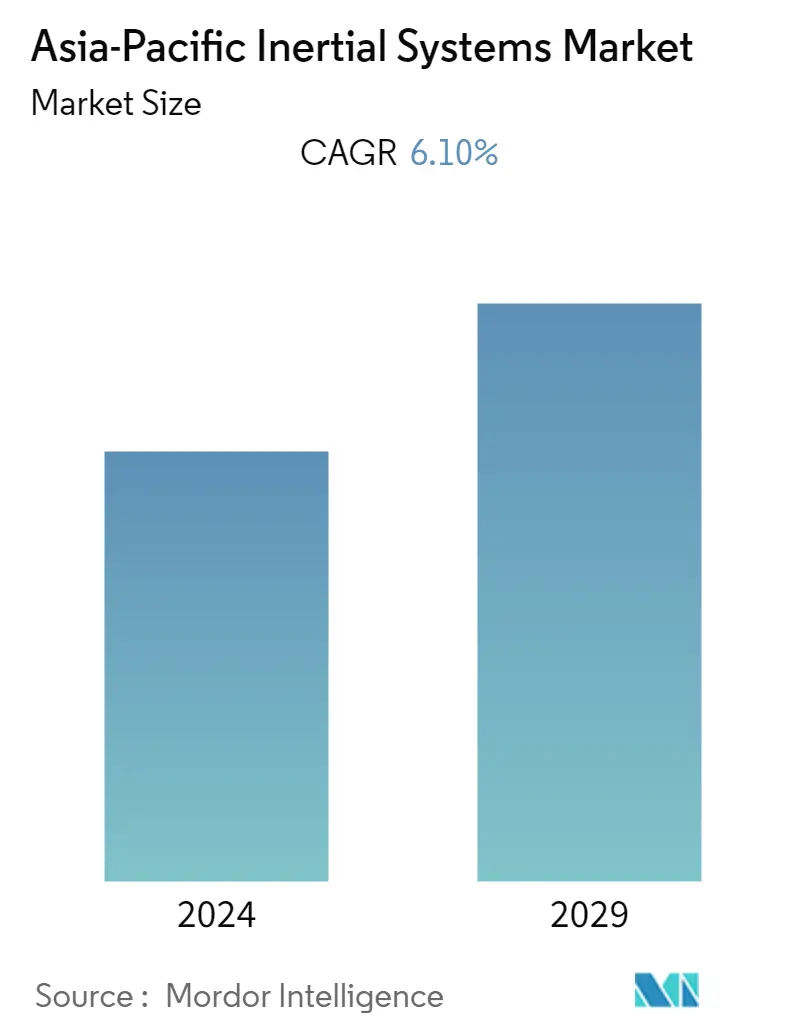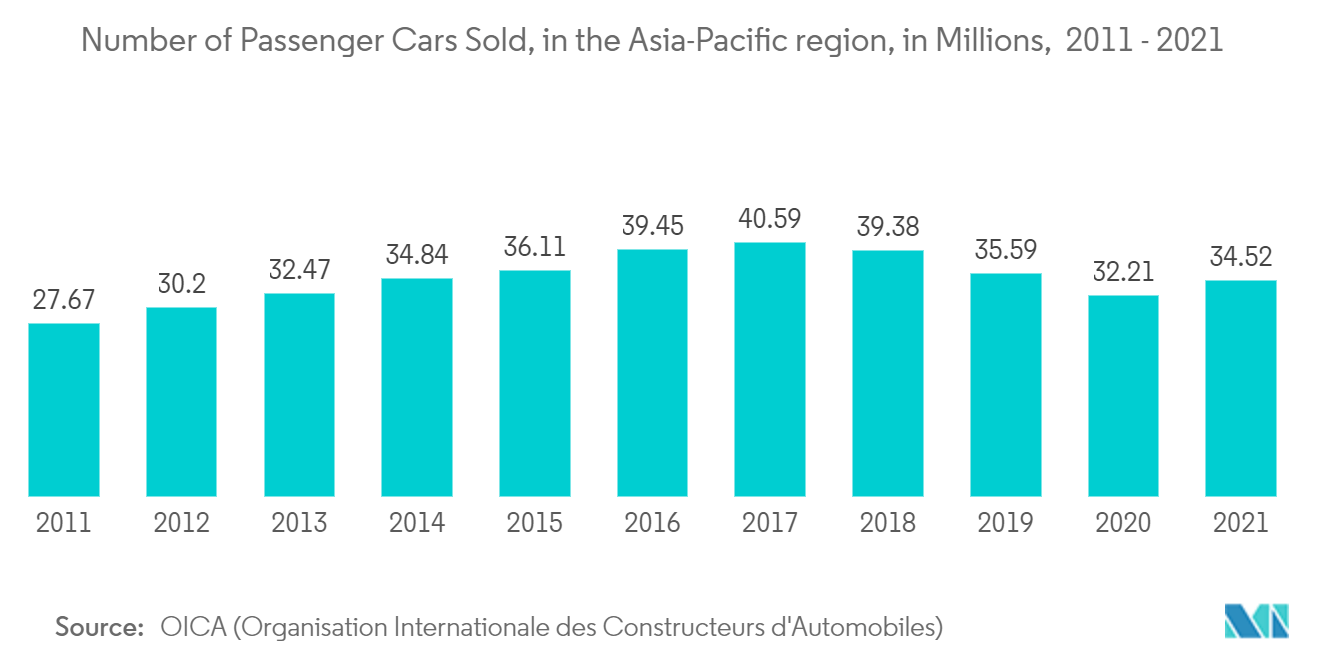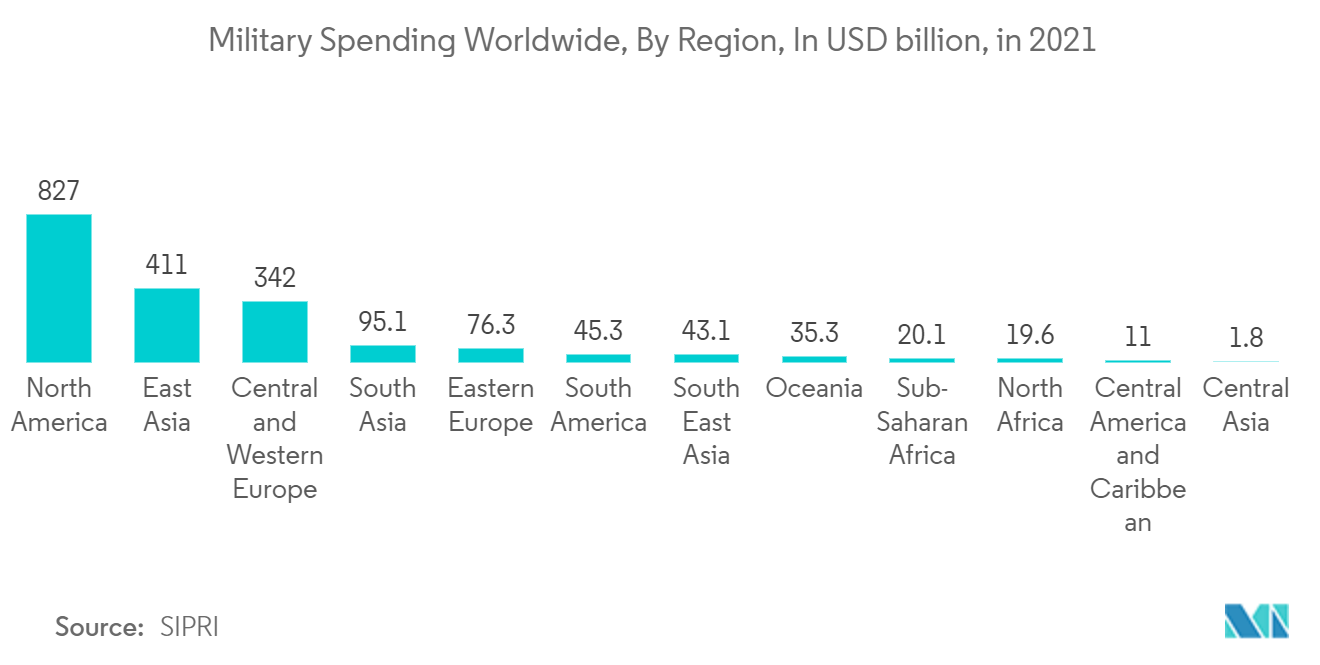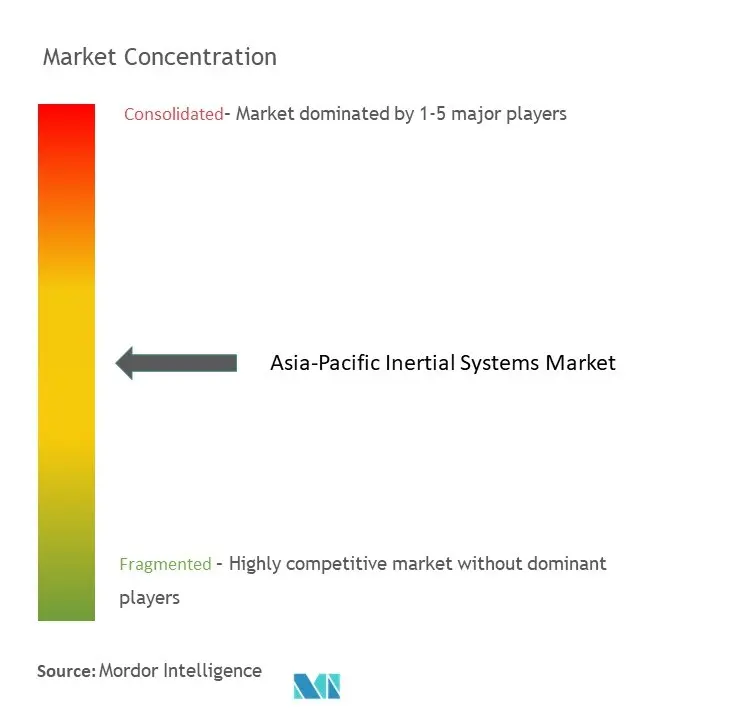APAC Inertial Systems Market Size

| Study Period | 2023 - 2029 |
| Base Year For Estimation | 2023 |
| Forecast Data Period | 2024 - 2029 |
| Historical Data Period | |
| CAGR | 6.10 % |
| Market Concentration | Medium |
Major Players
*Disclaimer: Major Players sorted in no particular order |
APAC Inertial Systems Market Analysis
The Asia-Pacific inertial system market is expected to register a CAGR of 6.1% over the forecast period.
- Asia-Pacific is home to the largest manufacturers and exporters of goods in the world. Also, countries like Indonesia, China, Japan, and India are the big powerhouses of industries. Domestic players and international organizations have large factories for exports and self-consumption in these countries. With the economy growing in this region, new companies from various parts of the world are looking to invest. Factories are operating more machines in the production lines to improve the speed and efficiency of production.
- The progress of the worldwide lifestyle has resulted in the requirement for equipment with greater comfort, allowing motion-sensing technology that broadly uses inertial sensors, which has become a key driving factor in this market.
- Further, it is anticipated to define the trend for the upcoming few years. The unprecedented increase in unmanned vehicles across different civilian and defense applications has raised the demand for complex navigational systems, including inertial sensors. Technological development has made sensors available and affordable, making their usage abundant in day-to-day devices.
- The growing integration of navigation systems such as GPS/INS and GNSS/INS added greater performance features than the traditional navigation system, thus, driving the inertial system market. In recent years, a substantial rise in demand for unmanned vehicles such as unmanned aerial vehicles (UAV), autonomous underwater vehicles (AUV), and remotely operated vehicles (ROV) across diverse applications in both defense and civilian applications fuelled the growth of the Asia-Pacific inertial navigation system market.
- COVID-19 significantly impacted various global markets due to lockdowns and multiple rules and regulations imposed by the government. The market returned to stability as the government in the regions eased the rules and regulations set earlier. The sales of the end-user market grew, which is anticipated to continue growing over the forecast period and drive the market.
APAC Inertial Systems Market Trends
This section covers the major market trends shaping the APAC Inertial Systems Market according to our research experts:
Increasing Demand for Accuracy to Drive the Market
- High levels of precision and dependability are the major features of navigational systems. Inertial navigational systems have a different advantage over other navigation systems in terms of their shortage of reliance on exterior aids to choose the rotation and acceleration of a moving object. These systems utilize a mixture of gyroscopes, accelerometers, and magnetometers to specify the vector variables of a vehicle or a moving object.
- Navigational systems are naturally suited for integrated navigation, control, and guidance of vehicles in challenging areas. Unlike GPS and other navigation systems, inertial systems can maintain performance even under challenging conditions. Inertial measurement units (IMU) are well-fitted to estimate several metrics for navigational systems. These systems stay unchanged by radiation and jamming problems. Strapdown inertial systems find better usage in inertial navigation systems than gimbaled systems, as they are strapped to the moving object and offer more reliability and performance. They offer cost-effectiveness as they are integrated with MEMS techniques.
- As advanced technologies like AI and machine learning become more broadly adopted, advanced robotics cars remotely controlled through sensor technology are becoming more common. As a result, correct position parameters, such as height and orientation of tactical-grade equipment, are essential in the current scenario.
- Inertial navigation systems are available for commercial use in private aircraft, UAVs, and military and defense units and constitute an integral part of navigational control systems. They can also interact with other navigational systems due to gradual advancements in the system's processing power. Several inertial systems, like magnetometers, are primarily used to specify the orientation and existence of a magnetic field in conjunction with other inertial systems.
- Multi-axis systems such as IMUs and AHRS are operated to determine moving objects' altitude, position, acceleration, and velocity. Inertial systems are perfect for delivering high accuracy in navigational systems by utilizing a mixture of accelerometers, gyroscopes, and magnetometers.
- Passenger cars are widely dependent on navigation systems, which are in constant demand in the region. According to the OICA (Organisation Internationale des Constructeurs d'Automobiles), in 2021, the Asia-Pacific region sold approximately 34 million passenger cars, including in the Middle East, of which China sold more than 21 million. The numbers are anticipated to increase in the region and drive the market.

Rising Military Applications and Expansions of MEMS May Drive the Market
- An indigenous mortar system, Dhanush, is a recent addition to the Indian army. The weapons have an inertial navigation system that directs missiles nearly 36 km away from the guns' placements. The new technology also includes auto-laying and GPS-based gun recording. The cannon calculates ballistics and measures onboard velocity through its features. Technologies like thermal imaging, cameras, and a laser range finder are crucial to inertial systems' improvement.
- IMUs in military operations, especially in unmanned aerial vehicles (UAVs), have stimulated companies to create advanced solutions for this technology. As a result, next-generation IMUs are primarily available on the market today.
- Inertial guidance systems are operated in almost every missile and precision-guided bomb in the military, which enables these weapons to target and precisely set their course in flight. Inertial guidance utilizes sensitive measurement sensors to measure the missile's location based on the acceleration applied after it vacates a known site. Commercial aircraft employ inertial navigation with a ring laser gyroscope, which is less exact than the mechanical systems used in ICBMs but still delivers a precise, somewhat fix on location.
- Military clashes are frequent in the Asia-Pacific region. The region's rising frequency of territorial conflicts has encouraged countries to purchase modern cruise missiles to strengthen their security. The evolution of military expenditures in different countries in the region has assisted the development and procurement of modern cruise missile systems, driving the industry forward.
- India and Pakistan continue to design their missile delivery systems and nuclear arsenals. The growing obstruction relationship between India, Pakistan, and China boosts the procurement and development of advanced military strategies such as airplanes, submarines, artillery, and missile systems, among other things.
- According to the SIPRI (Stockholm International Peace Research Institute), in 2021, the military spending of East Asia amounted to USD 411 billion, second to North America. South Asia, Southeast Asia, Oceania, and Central Asia spent USD 95.10 billion, USD 43.10 billion, USD 35.30 billion, and USD 1.80 billion, respectively.

APAC Inertial Systems Industry Overview
The Asia-Pacific inertial systems market is moderately fragmented due to the presence of different inertial systems solution providers. However, the vendors consistently focus on product expansions to improve their visibility and presence. The companies are also adopting strategic partnerships and acquisitions to gain market traction and increase their market share.
- July 2022 - Honeywell and Hanwha Systems announced the signing of an MOU to partner on unmanned aerial systems (UAS) and urban air mobility (UAM) technology expansion in South Korea. Established in South Korea, Hanwha Systems delivers distinguished smart technologies in information infrastructure and defense electronics. Honeywell is a major provider of UAS/UAM technology, providing a wide variety of ready-now technologies and assisting customers in building a more sustainable future for aviation. Under the terms of the MOU, the companies will investigate different hybrid propulsion solutions for applying Honeywell and Hanwha Systems' UAM platform extended portfolio of competitive offerings developed to help the UAS/UAM market.
- November 2022 - GAMECO and Thales signed an industrial collaboration agreement for further cooperation in MRO activities. Thales will continue to assist GAMECO in aircraft maintenance, the procurement distribution of aviation supplies, and technical documentation and Test Program Sets (TPS). Both companies, with this agreement, will maintain the collaboration momentum in contributing to the high-quality development of the Chinese civil aviation market with innovative products, solutions, and quality services.
APAC Inertial Systems Market Leaders
-
Honeywell Aerospace Inc.
-
Northrop Grumman Corporation
-
Bosch Sensortec GmbH
-
Analog Devices Inc.
-
Thales Group
*Disclaimer: Major Players sorted in no particular order

APAC Inertial Systems Market News
- November 2022 - Honeywell signed an MoU with NewSpace Research and Technologies, an emerging India-based developer of unmanned platforms, to collaborate on navigation systems for unmanned aerial systems. Both companies will bring improved operational capabilities to unmanned platforms for military use, leveraging Honeywell's advanced navigation technologies. Honeywell will also provide its Resilient Navigation System, which enables UAVs to navigate autonomously denied environments in Global Navigation Satellite System (GNSS).
- November 2022 - Collins Aerospace and China's Hainan Airlines signed a FlightSense contract to deliver Hainan Airlines' fleet of Boeing 787s with customizable support solutions to lessen repair time and costs. The contract with Hainan Airlines, which builds on a 30-year relationship between the two organizations, includes 185 aircraft on multi-platforms through 2025. Collins will assist in ensuring the availability of Hainan Airlines' maintenance, repair, and overhaul (MRO) supply chain management.
APAC Inertial Systems Market Report - Table of Contents
1. INTRODUCTION
- 1.1 Study Assumptions and Market Definition
- 1.2 Scope of the Study
2. RESEARCH METHODOLOGY
3. EXECUTIVE SUMMARY
4. MARKET INSIGHTS
- 4.1 Market Overview
- 4.2 Industry Value Chain Analysis
-
4.3 Industry Attractiveness - Porter's Five Forces Analysis
- 4.3.1 Bargaining Power of Suppliers
- 4.3.2 Bargaining Power of Consumers
- 4.3.3 Threat of New Entrants
- 4.3.4 Intensity of Competitive Rivalry
- 4.3.5 Threat of Substitutes
5. MARKET DYNAMICS
-
5.1 Market Drivers
- 5.1.1 Emergence of MEMS Technology
- 5.1.2 Inclination Toward Defense and Aerospace
- 5.1.3 Technological Advancements in Navigation Systems
-
5.2 Market Restraints
- 5.2.1 Operational Complexity and High Maintenance Costs
6. MARKET SEGMENTATION
-
6.1 By Application
- 6.1.1 Civil Aviation
- 6.1.2 Defense
- 6.1.3 Consumer Electronics
- 6.1.4 Automotive
- 6.1.5 Energy and Infrastructure
- 6.1.6 Medical
- 6.1.7 Other Applications
-
6.2 By Component
- 6.2.1 Accelerometer
- 6.2.2 Gyroscope
- 6.2.3 IMU
- 6.2.4 Magnetometer
- 6.2.5 Attitude Heading and Navigation System
- 6.2.6 Other Components
7. COMPETITIVE LANDSCAPE
-
7.1 Company Profiles
- 7.1.1 Honeywell Aerospace Inc.
- 7.1.2 Northrop Grumman Corporation
- 7.1.3 Bosch Sensortec GmbH
- 7.1.4 Analog Devices Inc.
- 7.1.5 Thales Group
- 7.1.6 Rockwell Collins Inc.
- 7.1.7 Moog Inc.
- 7.1.8 Fairchild Semiconductor (ON Semiconductors)
- 7.1.9 VectorNav Technologies
- 7.1.10 STMicroelectronics NV
- 7.1.11 Safran Group (SAGEM)
- 7.1.12 InvenSense Inc.
- 7.1.13 Meggitt PLC
- *List Not Exhaustive
8. Vendor Market Share Analysis
- 8.1 Vendor Positing Analysis (Inertial Systems)
- 8.2 Vendor Market Share (High-end Inertial Systems)
- 8.3 Vendor Market Share (MEMS Industry)
9. INVESTMENT ANALYSIS
10. FUTURE OF THE MARKET
** Subject To AvailablityAPAC Inertial Systems Industry Segmentation
An inertial guidance system (IGS) is an electronic system that constantly monitors a vehicle's location, velocity, and acceleration, commonly a submarine, missile, or airplane. Gyroscopes, accelerometers, and a computer are the essential components of an inertial guidance system.
The scope of the market is limited to the Asia-Pacific region only. The market is segmented by equipment, grade, and country. The market sizes and forecasts are provided in terms of value (USD million) for all the above segments.
APAC Inertial Systems Market Research FAQs
What is the current Asia-Pacific Inertial Systems Market size?
The Asia-Pacific Inertial Systems Market is projected to register a CAGR of 6.10% during the forecast period (2024-2029)
Who are the key players in Asia-Pacific Inertial Systems Market?
Honeywell Aerospace Inc., Northrop Grumman Corporation, Bosch Sensortec GmbH, Analog Devices Inc. and Thales Group are the major companies operating in the Asia-Pacific Inertial Systems Market.
What years does this Asia-Pacific Inertial Systems Market cover?
The report covers the Asia-Pacific Inertial Systems Market historical market size for years: 2023. The report also forecasts the Asia-Pacific Inertial Systems Market size for years: 2024, 2025, 2026, 2027, 2028 and 2029.
Asia-Pacific Inertial Systems Industry Report
Statistics for the 2024 Asia-Pacific Inertial Systems market share, size and revenue growth rate, created by Mordor Intelligence™ Industry Reports. Asia-Pacific Inertial Systems analysis includes a market forecast outlook to 2029 and historical overview. Get a sample of this industry analysis as a free report PDF download.



